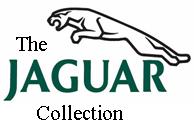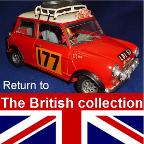Jaguar was the name given to several models produced by the SS Car Co., in the late 30’s, and was then chosen as the new company name in 1945 after the second world war.
The SS story began in Blackpool in 1922, when Wm. Lyons and Wm. Walmsley formed the Swallow Sidecar Co. Their success enabled them, in 1926, to fulfil an ambition of entering into car bodywork. The car they chose to endow with specialist coachwork was, interestingly enough, the very car that most threatened their livelihood as sidecar makers - the Austin 7.
In March 1935 the first true SS sports car appeared. It was the 2-seater SS90 with a 20 hp 2663cc engine. Six months later came the OHV SS 100 Jaguar. The Jaguar suffix was then adopted for all models. 0-50 in 20 seconds was hardly startling performance but the exaggerated low styling created the desired effect, and public response was good.
The SS100 was built between 1936 and 1940. The last one is thought to have been delivered in 1941. In 1936 the name Jaguar was given to a new saloon car and from then on to all the cars. Following WWII, because of the connotations then attached to the initials "SS" the company was renamed Jaguar.
The engine was a development of the old 2.5ltr 'Standard' unit converted from side valve to OHV with a new cylinder head designed by William Heynes and Harry Weslake. Power output rose from 70bhp to 100bhp.
On test by the Autocar magazine in 1937 the 2.5Ltr car was found to have a maximum speed of 95mph and a 0-60 mph time of 13.5 seconds. The 3.5Ltr car reached the magic 100mph with a best of 101mph over the quarter mile and the 0-60mph coming down to10.4 seconds.
In 1937 the 2.5Ltr car cost £395 and in 1938 the 3.5Ltr £445. The coupe, of which only on was made, was listed at £595. A few examples were supplied as chassis only to external coachbuilders.
Widely considered to be the most aesthetically pleasing Jaguar cars it is also one of the rarest, with only 198 of the 2.5Ltr and 116 of the 3.5Ltr models being made. Most stayed on the home market but 49 were exported. Cars in good condition will fetch in excess of £100,000; a near concours example was sold by auctioneers 'Bonhams' at the Goodwood festival of speed in 2007 for £199,500.



1/24th scale kit.
Built by Rod.

Restored in June 2003, from a previously built SEF metal kit, this car model was totally striped down and rebuilt up to today’s standard. Many older models would benefit from the techniques and materials available today and we quite often debate the pro’s and con’s of restoring model cars. In much the same way as the original car enthusiasts debate restoring older cars because something of the originality is inevitably lost with any rebuild.
Generally speaking we would not restore a model, unless it was falling to pieces, in order to show the development of modelling over the years. That said we our sometimes are donated, or acquire, previously built models that need some love and attention.
Building a metal model kit is not that different to building a plastic kit, you can read more about building metal models in our projects and articles pages.
RETURN TO -

